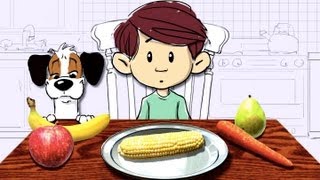(单词翻译:单击)
Ever wonder where most of the food you eat every day comes from?
有没有想过你每天吃的食物大部分都是从哪里来的?
Well, about 60% of the food you eat is carbohydrates.
事实上,大约60%的食物是碳水化合物。
As you can probably tell from its name, carbohydrates contain carbon, hydrogen, and oxygen.
从名字或许就会看出,碳水化合物包含碳,氢和氧气。
But where do these atoms originally come from
但是这些原子最初来自哪里呢?
and how do they join together to make delicious foods like fruits and pasta?
它们又是如何组合来产生美味的食物,如水果和意大利面的呢?
It actually all starts with the air you are exhaling this very minute, specifically the carbon dioxide molecules.
实际上,一切都是从你此刻呼吸的空气开始的,尤其是二氧化碳分子。
Plants are going to breath in this very same carbon dioxide through pores in their skin, called stomata.
植物会通过其表面被称为气孔的微孔吸入这些二氧化碳。
Plants drink in water from their roots to get the needed oxygen and hydrogen atoms,
植物还会通过根茎从土壤吸收水分,以获得所需的氧和氢原子
and their electrons, in order to build carbohydrates. What is that thing?
以及它们的电子,从而产生碳水化合物。那是什么?
Well, that's a special plant organelle inside the leaves of plants called a chloroplast.
哦,那是一个特殊的植物细胞器,在植物的叶子内,叫叶绿体。
It's green beceause of a special light-absorbing pigment called chlorophyll.
由于一种特殊的称作叶绿素的采光色素,它才是绿色的。
Each leaf has about 44,000 cells and every cell can have anywhere between 20 to 100 chloroplasts.
每片叶子有大约4万4千个细胞,每个细胞含有20到100个叶绿体。
That's up to 4,400,000 chloroplasts!
算下来有最多440万个叶绿体!
By now, you've probably guessed that we're talking about the process of photosynthesis
现在,你也许已经猜到我们在讨论光合作用的过程,
and you might be wondering when the sun is going to make its entrance.
你也许想知道太阳是怎么参与这个过程的。
Let's go back to that original molecule of water.
让我们回到水原来的分子状态。
The plant has to split this molecule of water so it can get electrons from it.
植物必须将水分子分解以获取其中的电子。
But, the plant can't pull that water apart by itself.
但是,植物本身不能分解水分子,
It needs help from the high-energy rays of the sun.
它需要来自太阳的高能射线的帮助。

So now that the chloroplast has all the building blocks - carbon, hydrogen, oxygen, and electrons
现在叶绿体有了所有的构件:碳,氢,氧气和电子,
it can use them to go through the rest of the steps of photosynthesis
叶绿体利用这些构件来完成光合作用的剩余步骤,
to transform that original carbon dioxide gas into a simple carbohydrate called glucose, C-6-H-12-O-6.
将原始的二氧化碳气体转化为一种简单的碳水化合物:葡萄糖,C-6-H-12-O-6。
That little glucose molecule then helps to build bigger and better carbohydrates like cellulose.
然后,这个小小的葡萄糖协助生成更大更高等的碳水化合物,比如纤维素。
Cellulose is a type of carbohydrate found in plants that our body cannot break down.
纤维素是在植物中发现的一种碳水化合物,人类的身体无法分解它。
We call it fiber and we eat it in vegetables like lettuce, broccoli, and celery.
我们称之为纤维,可以在蔬菜中吃到,如莴苣,西兰花和芹菜。
Plants use cellulose to keep themselves strong.
纤维素可以保持植物的坚韧度。
The plant could also turn that glucose into starch, a large molecule that stores energy for the plant.
植物也可以将葡萄糖转化为淀粉,一种帮助植物存储能量的大分子。
We love eating starch from plants like potatoes, corn, and rice.
大家喜欢吃来自食物的淀粉,如土豆,玉米和大米。
So you see, when you eat plants, we're actually benefiting from photosynthesis.
所以,当你吃植物的时候,实际上是受益于光合作用。
The plant makes things like starch, which we eat and then break back down into glucose, the first form the plant made.
植物生产我们能吃的东西,例如淀粉,然后分解成葡萄糖,即其初始形态。
Then, the mitochondria in our cells, powered by the oxygen we breath,
接着,我们体内的线粒体,由我们吸入的氧气提供动力,
can turn glucose into pure energy molecules called ATP.
能将葡萄糖转化为纯粹的能量分子,叫做ATP。
ATP powers all work done by each and every one of your cells, things like communication, movement, and transport.
每一个细胞完成的事情,全部是由ATP提供动力的,比如通讯,移动和传递。
But why do we have to turn that glucose into ATP? Well, think of it like this.
但为什么我们必须将葡萄糖转化为ATP?可以这样理解。
You're excited to start your summer job at the local ice cream stand,
你很高兴开始在本地冰激淋店的暑期工作,
but your boss has just told you that she is going to pay you in ice cream cones.
但你的老板告诉你,你的报酬是甜筒。
What are you going to be able to do with those ice cream cones?
你能怎么处理这些甜筒呢?
Nothing, which is why you kindly asked to be paid in dollars. ATP is just like dollars.
什么也做不了,这就是你为什么要求以美元支付你的薪酬。ATP就相当于美元。
It is the currency that all cells of life use while glucose is, well, kind of like ice cream.
它是生命体所有细胞共同使用的货币,至于葡萄糖,就相当于冰激淋。
Even plants have mitochondria in their cells to break down the glucose they make into ATP.
每个植物细胞也都有线粒体,能将生成的葡萄糖分解成ATP。
So as you can see, humans and plants are intricately connected.
正如你看到的,人类和植物之间有着复杂的联系。
The air we breath out is used by plants to make the carbohydrates we enjoy so much.
我们呼出的空气被植物用来生成我们喜爱的碳水化合物。
And, in the process, they are releasing the very same oxygen molecules we need to breath in
于此同时,植物也会释放出我们需要吸入的氧气分子,
in order that our mitochondria can break down our delicous carbohydrate meal.
这样我们细胞内的线粒体就能分解我们吃掉的碳水化合物美食了。


